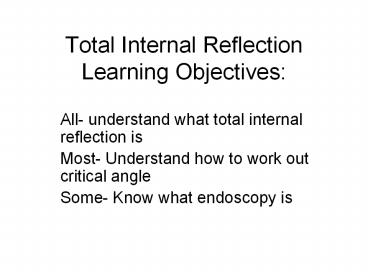Total Internal Reflection Learning Objectives: - PowerPoint PPT Presentation
1 / 18
Title:
Total Internal Reflection Learning Objectives:
Description:
Total Internal Reflection Learning Objectives: All- understand what total internal reflection is Most- Understand how to work out critical angle – PowerPoint PPT presentation
Number of Views:149
Avg rating:3.0/5.0
Title: Total Internal Reflection Learning Objectives:
1
Total Internal ReflectionLearning Objectives
- All- understand what total internal reflection is
- Most- Understand how to work out critical angle
- Some- Know what endoscopy is
2
P1 E Part 2
- Rebounding Light
3
Optical Fibre
- I have in front of me a light source.
- Does any one know the name of the light source?
- This is known as a fibre optic or an optical
fibre. - What is different about this light source?
- In an optical fibre the end of the light is
bright because the light is bouncing around
inside the fibre until it gets to the end. - Draw an optical fibre and show me how you think
the ray of light travel along it. Can Do Task
1 Point
4
How does light travel?
- Light Travels in a straight line.
- Reflection is found when light rebound of a
mirror. - Refraction happens when light travels from one
material to another. The ray of light is no
longer straight. - Activity 1.
- Set up your ray box.
- Draw a line on the piece of paper, showing light
travelling in a straight line. - Put a mirror in front of the light beam and draw
the light being reflected - Put a piece of glass in front of it and show the
light being refracted. - Label your lines, Reflection and Refraction.
5
Labelling up
- Label your diagram, with the normal,
perpendicular to the mirror, measure your angle
of incidence and your angle of reflection using
the protractor.
6
Labelling Up.Draw the Normal again, measure your
angle of incidence, measure the angle of
refraction.Was your angle of incidence larger or
smaller than the angle of refraction.
7
Refraction
- Light normally travels in
- straight lines, but it can
- bend at the boundary
- between two materials
- with different densities.
8
Reflection or Refraction
- Decide which is which from below.
- Reflection, Angle of Incidence, Angle of
Reflection, Angle of Refraction
A
D
E
B
C
9
Critical Angle
- Waves going from a dense medium (e.g. Perspex) to
a less dense medium (e.g. air) speed up at the
boundary. - This causes light rays to bend when they pass
from glass to air at an angle other than 90. - Beyond a certain angle, called the critical
angle, all the waves reflect back into the glass.
We say that they are totally internally
reflected.
10
Critical Angle
- Can do Task Calculate the critical angle of
your block of perspex. 3 Points - Draw your block and draw your normal.
- Draw a line 30 degrees from the normal.
- Draw a line 60 degrees from the normal.
- Put your light source on the thirty line and move
it to the sixty slowly. - Stop when the light ray is refracted by 90
degres. - Record the angle on your piece of paper. You will
only be awarded the three point task if you have
got the correct angle.
11
The Critical Angle
12
Critical Angle
- Have a go at calculating the critical angle for
your piece of glass. - This is the angle of incidence when the angle of
refraction becomes 90 degrees. - Once you have done this use the prisms to try and
complete the sheet to figure how a periscope
works.
13
The angle of incidence at which maximum
refraction occurs is called the critical angle,
c.
For water this is about 49. For angles greater
than this total internal reflection results
14
Total Internal Reflectioninternal, optical,
little, bent, light,
- An -------- fibre is a thin rod of high-quality
- glass. Very ------ light is absorbed by the
- glass. ------ getting in at one end undergoes
- repeated total ---------- reflection, even when
- the fibre is -----, and emerges at the other
- end.
15
Up Periscope
- If you have two right angled prisms, you can make
a periscope which reflects the light at right
angles around a corner. - In your groups, have a go at making a persicope
with your two perspex blocks. - Show me how it works.
16
Submarines 5 Min
- Explain how total internal refraction might be
used in submarines.
17
- They are used in telecommunications to transmit
telephone conversations and data - Whilst traditional copper wires can be used (and
indeed are for the first 500 m or so from your
phone) they cannot carry as much information and
suffer from magnetic interference
18
Endoscopy
- Optical fibres are used in endoscopes that allow
surgeons to see inside their patients. - The endoscope is a long flexible tube that can be
swallowed. - It has a camera and light inside it.































